Search ads may not be as flashy as display or social ads, but they get the job done. Google processes about 8.5 searches per day, and 95% of that traffic goes to the first page of search results. Getting to that first page organically takes a lot of time and effort, and that’s where Google Ads come into play. Google ads target specific keywords and search terms to bump brands up the SERPs. However, just running a Google campaign does not guarantee success, nor is it a shortcut. It can get really expensive if your strategy doesn’t work.
So how do you shine in a world where everybody gets the same 90 characters of blue text, and your choice of words can directly impact your Quality Score and Ad Rank? It’s tricky but very much possible. In the article below, we’ll break down 10 examples of wonderfully executed Google Ad campaigns, both from the SaaS and eCommerce industries.
Best Google Ad Examples – SaaS
1. Upwork
Upwork is a platform for freelancers in fields like graphic design, writing, and web development. The site helps professionals to find projects and companies to hire freelance talent. Therefore, there are two different target audiences – businesses and individual professionals. Here we’re looking at their ads aimed at businesses.
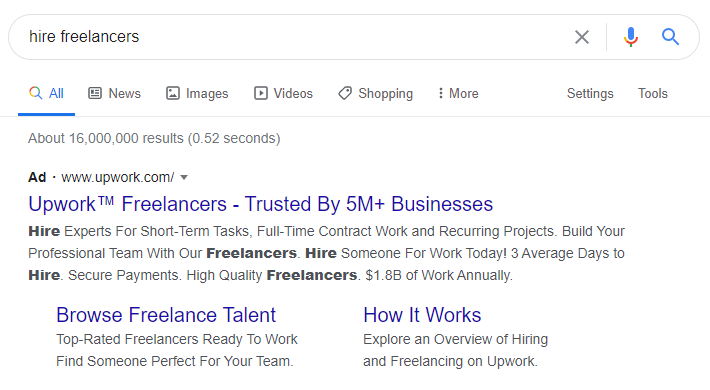
Highlights:
- Builds trust – the ad copy uses the best way to build trust within new users – social proof (Trusted By 5M+ Businesses). And to make sure it’s not lost on anyone, it’s part of the main title.
- Site link extensions – the extensions direct users to the most important pages such as how it works, browse freelancers, etc, which is expected to improve the click-through rate of the ad.
- Resolves searcher’s problem -The limited amount of characters is used wisely, as the copy resolves two potential problems – the process is fast (“ 3 Average days to hire”) and the payments are secure.
2. HoneyBook
HoneyBook is a customer relationship management (CRM) and financial management platform. It helps users manage projects, book clients, send invoices and handle payments. Just like…Freshdesk.
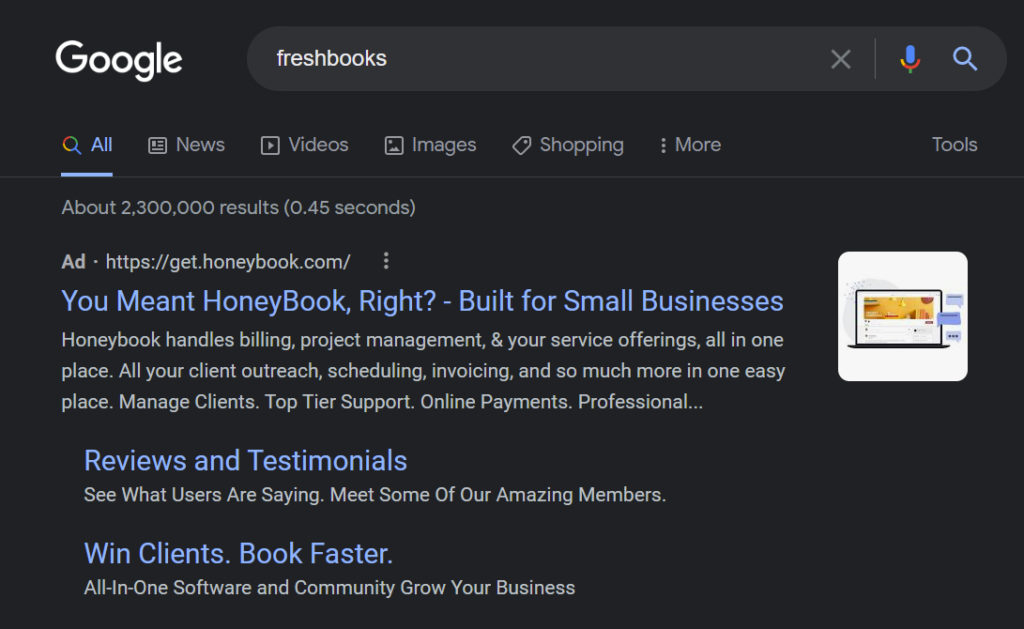
Highlights:
- Bidding on a competitor brand name – This strategy can be risky, but in HoneyBook’s case it paid off. The tongue-in-cheek copy shows off the brand’s personality and grabs the user’s attention. While bidding on competitors’ names is no longer banned by Google, be cautious when doing so. It could make your competitors angry or seem off-putting to your audience. It can work if you’re smart and upfront about it, like HoneyBook is in this ad.
- Sitelinks – Just like in the previous example, we see sitelinks here too. Remember, you can optimize your ad for sitelinks, but Google decided whether or not they appear in your ad.
3. Shopify
Shopify is an eCommerce platform that makes it easy for sellers to launch and manage their own online stores. It offers multiple integrations and features for businesses of all sizes.
Example #1
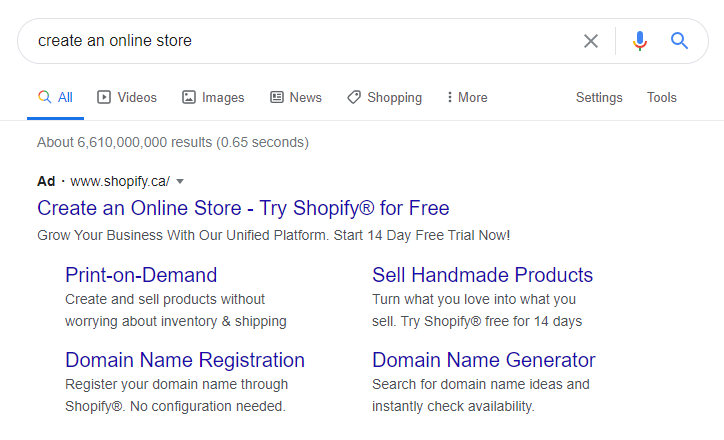
Example #2
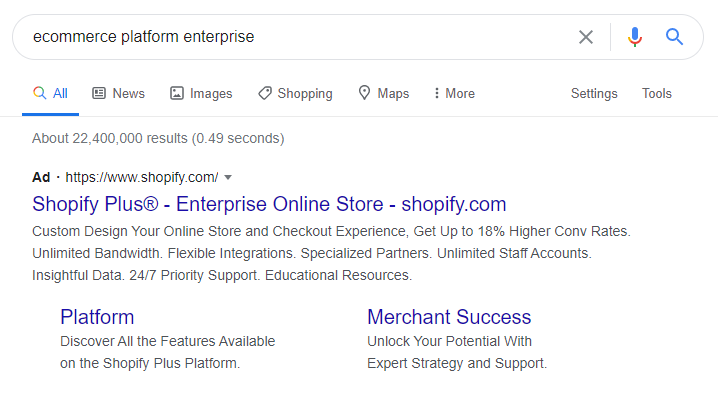
Highlights:
- Segmented ads – Small, medium, and large-sized businesses have different needs. So, Shopify created different ads for different segments of its target audience.
Take a look at example #1: This ad is targeted at the search query “online store builder” and clearly focuses on small businesses. The sitelinks address concerns first-time eCommerce business owners might have: how to register a domain, for example. The second example targets enterprise-level businesses and focuses on the common concerns of an established business. Benefits like “up to 18% higher conversion rates” and “unlimited staff accounts” show how a large company can grow with Shopify. - Customized landing pages – Many marketers focus almost entirely on the pre-click phase of their Google ad campaigns. However, what elevates your campaign from good to great is creating a compelling post-click experience as well.
Shopify invests in a customized post-click experience for each of its audience segments. Not only do they customize the ads for each target segment with different benefits, CTA, and site extensions, but they use different landing pages too. Each landing page is different and optimized for a different type of audience, including messaging, design, and CTAs.
4. Wix
Wix is a cloud-based website builder that includes web hosting and design services. It includes drag-and-drop tools and ready-made templates that allow users to build a professional-looking website without either having specialist skills or hiring a web developer.
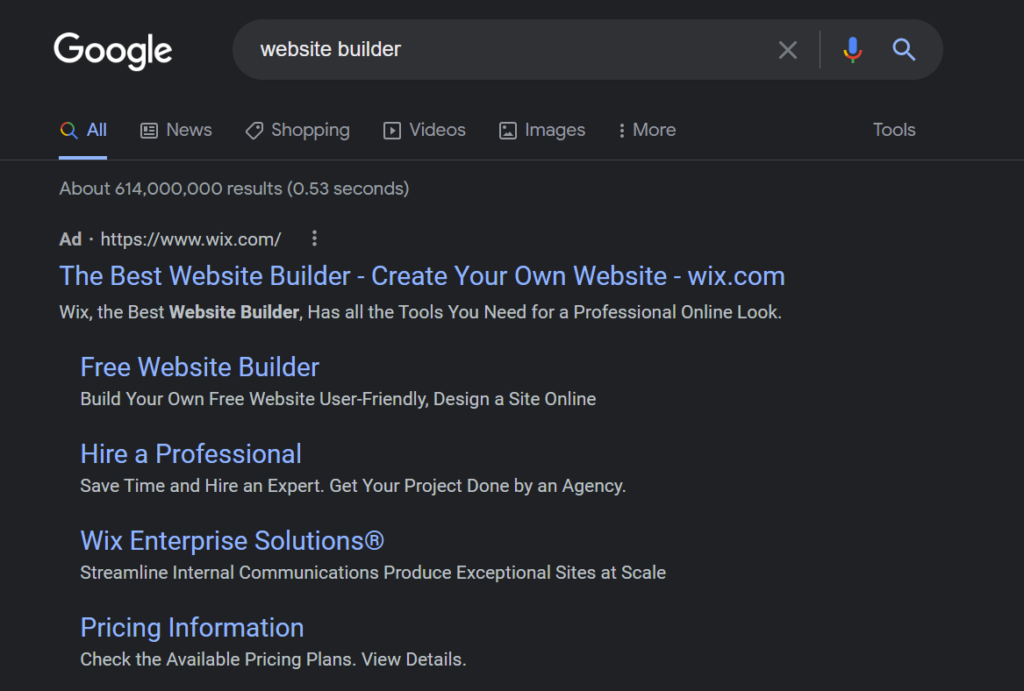
Highlights:
- Targets high traffic keywords – From the copy of this ad it’s clear that the target keyword was ‘best website builder’. This strategy serves two purposes: positions Wix as an industry leader, and reaches a lot of eyeballs (best site builder is a very popular search term).
- Optimized sitelinks – All of the sitelinks that appear in this ad focus on the company’s unique value proposition (UVP) or its most popular features.
5. Semrush
Semrush is software that helps companies manage their digital marketing. It offers tools for keyword research, SEO, campaign management, and more.
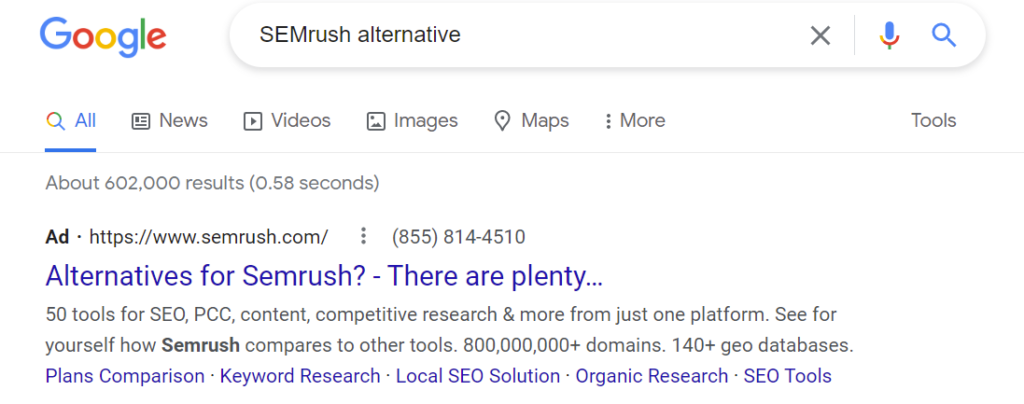
Highlights:
Stealing traffic from competitors – We’ve already talked about bidding on competitors’ names, and bidding on terms like “X alternative” or “X vs. [competitor]” is a very popular strategy. That’s because it’s a common search query for users who are in the consideration phase of the marketing funnel, thus it has the potential of driving excellent ROI.
In this example, however, Semrush themselves are using the words “alternatives to Semrush”. Essentially, they are saying “yes, there are alternatives but we are better.” The ad copy and the landing page messaging outline the benefits of choosing Semrush over those alternatives.
Best Google Ad Examples – eCommerce
1. Glossier
Glossier is a beauty brand that primarily aims to target young women who have a lower budget but also appreciate high-quality products.
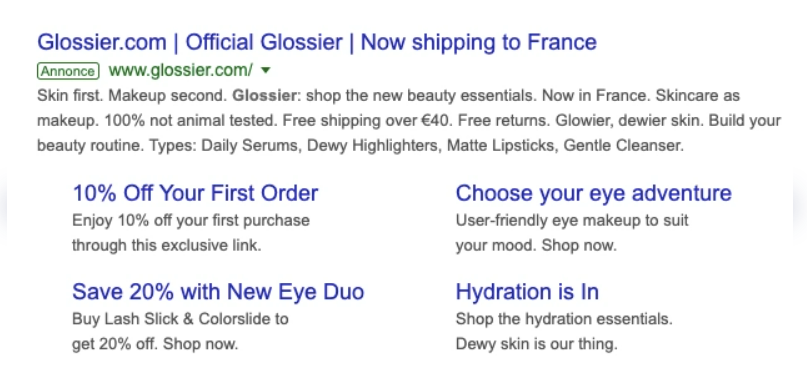
Highlights:
- Promotes different product lines – Glossier uses sitelinks to expose shoppers to new products.
- Personalization – the copy used in the ad (“choose your eye adventure”) creates a human connection and personalizes the experience for the shopper.
- Highlights discounts – the ad for the new product offers a percentage-off discount, giving shoppers an incentive to click it. Adding discount offers to Google ads is generally advised for extremely high-intent keywords.
2. Mimijumi
Mimijumi is a baby geat brand, whose hero product is a baby bottle that is designed to mimic the breastfeeding experience. Their products are manufactured in Europe to exceed US safety standards and their bottles come with a built-in anti-colic and anti-gas system.
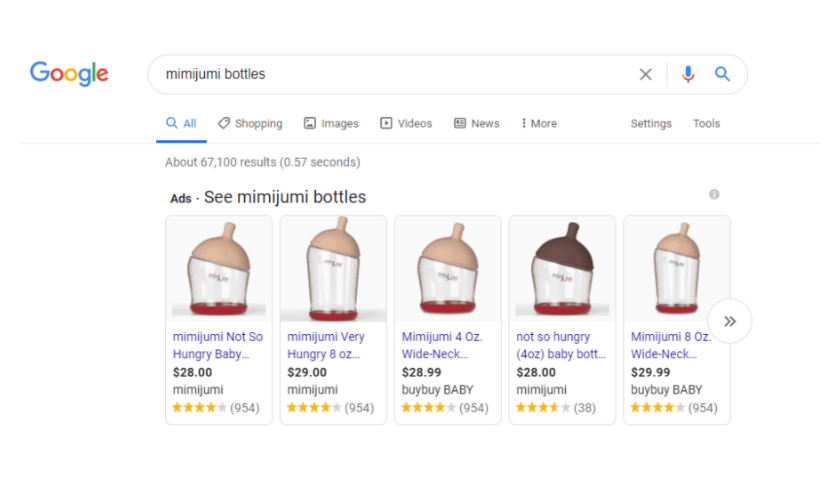
Highlights:
- Own brand campaign – Mimijumi optimized their Google Shopping campaigns properly to show up for searches for their own brand name. Sounds obvious? You’d be surprised how many brands overlook that strategy. The search term “Mimijumi bottle’ yields four results that direct back to the company’s website and one result for the bottles at a major chain store, giving Mimijumi credibility as a brand.
3. JCPenney
JCPenny is one of the largest retailers in the US, selling apparel, home, jewelry, and beauty products.

Highlights:
- Phone number extension – As a well-known department store that JCPenny’s target audience has a wide age range. Even if you don’t think it’s necessary to include a phone number for a product like costume jewelry, it could increase the ad CTR, and build trust in senior shoppers.
4. GetHarley
GetHarley is a UK-based platform that connects clients to the country’s most acclaimed dermatologists for a one-on-one virtual consultation. The practitioner will then prescribe the best course of action, including recommendations for products from a range of brands (no practitioner is associated with a brand). If the client decides to purchase those products they can do so with a few quick clicks, and the products will arrive at their doorstep in a matter of days.
Highlights:
- Targeting trending keywords – When googling ‘cruelty-free skincare’ GetHarley’s ad is one of the first results to pop up. They also leverage keywords like ‘sustainable’ and ‘delivered to your door’ which are great attention grabbers.
- Image extension – The image of a GetHarley delivery box on the search ad shows off the product before the user has even clicked the ad.
5. Tails
Tails is a tailor-made dog food brand that makes personalized blends based on the dog’s age, breed, lifestyle, and more.

Highlights:
- Discount for first-time shoppers – ‘First Box 75%’ is one of the first things that stands out from the headline. This is a huge discount that is sure to draw in many shoppers.
- Social Proof – Using “30,000 Positive Reviews as a link is a very smart move, giving the brand credibility.
Final Thoughts
Google ads help you show up in search results, but that’s only the first step. To stand out you need to be savvy about your Google campaigns. Understanding which keywords to target, how to personalize the experience for your target audience, and which options to offer based on different search intents is what will help you actually drive traffic to your site and increase conversions.
Take inspiration from the SaaS and eCommerce brands we listed above. Try adding reviews and playing around with sitelinks and images. And of course, always, always, always be testing.



